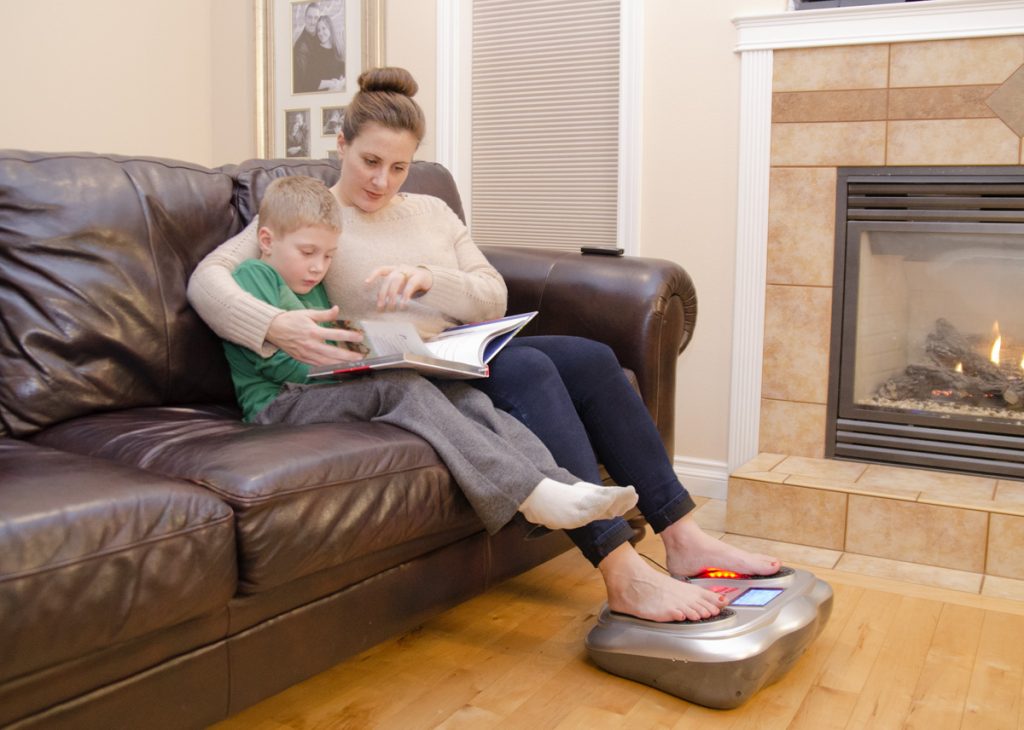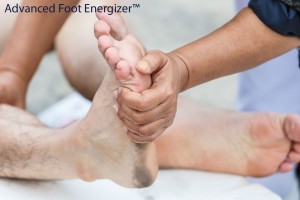 A common problem with electrodes is finding the right places to attach them for maximum relief and benefit when using a TENS unit for foot pain. It’s a process of trial and error – even for Doctors, Physical therapists and other health care professionals. This applies to EMS and other Neurostimulation modes as well.
A common problem with electrodes is finding the right places to attach them for maximum relief and benefit when using a TENS unit for foot pain. It’s a process of trial and error – even for Doctors, Physical therapists and other health care professionals. This applies to EMS and other Neurostimulation modes as well.
Using a TENS Unit For Foot Pain – Enter the Advanced Foot Energizer
Using the Advanced Foot Energizer as a TENS and EMS unit for foot pain is marvelous for the simple reason it eliminates placement guess work and treats the entire area evenly. It’s the special plantar foot pads that allow the Energizer to perform as large foot fitting electrodes.
 The bottom of our feet is like a fuse box. There are several pressure points on the bottom of our feet and these pressure points are associated with other parts of out body. By stimulating the pressure points the body part associated with the pressure point is also stimulated. The Advanced Foot Energizer stimulates these pressure points while at the same time activating your circulation in your feet and legs. It is by far the easiest method of using a tens unit for foot pain.
The bottom of our feet is like a fuse box. There are several pressure points on the bottom of our feet and these pressure points are associated with other parts of out body. By stimulating the pressure points the body part associated with the pressure point is also stimulated. The Advanced Foot Energizer stimulates these pressure points while at the same time activating your circulation in your feet and legs. It is by far the easiest method of using a tens unit for foot pain.
The foot pads on the Advanced Foot Energizer are divided into different areas that target individual parts of your feet. Chinese medicine traditionally refers to these areas as “foot meridians”. In reflexology, the understanding is that all the different parts of your body are connected to the soles of your feet. Stimulating the specific areas of the bottom of your feet can help to improve your overall health. Because it uses this unique combination of both Western and Chinese medicine techniques the Advanced Foot Energizer is an excellent choice for treating feet that are tired and painful.
Please note that if you have neuropathy you may not feel the stimulation right away, even at full strength. Customers report either feeling the stimulation immediately to up to two weeks before feeling the sensation with consistent use. Take it at your pace but use it at lease once or twice per day for at least 25 minutes. Consistent use is the key; don’t expect to get the same results sitting down for two hours once a week as you would if you used the Advanced Foot Energizer 25 minutes every day. You may also use the body pads to apply stimulation concurrently to your calf muscles increasing the circulation even further. If you suspect you have or have been diagnosed with neuropathy visit with your doctor about using electrical stimulation for your feet.
 A must for runners, cyclists or anyone with foot and ankle pain
A must for runners, cyclists or anyone with foot and ankle pain
If you are a runner, hiker, or cyclist with foot and ankle pain then the Advanced Foot Energizer is the perfect tool for post workout recovery. It is relaxing and really eases pain from running on trails and roads. The body pads can be used to stimulate your knees or leg muscles at the same time as you are treating your feet, helping to condition your muscles and speed recovery time.
Great product! I use it to smooth out the aches and pains in my feed and legs during my half marathon training. It takes the edge off and really does make a difference. Great to use while watching TV or reading. Highly recommend one of these! – Phil Snyder
 Try the Advanced Foot Energizer risk free with our 60-day buy back guarantee and get back to running, cycling, hiking, or walking faster!
Try the Advanced Foot Energizer risk free with our 60-day buy back guarantee and get back to running, cycling, hiking, or walking faster!
Abstracts and further reading:
Activation of human plantar flexor muscles increases after electromyostimulation training
Nicola A. Maffiuletti, Manuela Pensini, Alain Martin
Journal of Applied Physiology Published 1 April 2002 Vol. 92 no. 4, 1383-1392 DOI: 10.1152/japplphysiol.00884.2001
Neuromuscular adaptations of the plantar flexor muscles were assessed before and subsequent to short-term electromyostimulation (EMS) training. Eight subjects underwent 16 sessions of isometric EMS training over 4 wk. Surface electromyographic (EMG) activity and torque obtained under maximal voluntary and electrically evoked contractions were analyzed to distinguish neural adaptations from contractile changes. After training, plantar flexor voluntary torque significantly increased under isometric conditions at the training angle (+8.1%, P< 0.05) and at the two eccentric velocities considered (+10.8 and +13.1%, P < 0.05). Torque gains were accompanied by higher normalized soleus EMG activity and, in the case of eccentric contractions, also by higher gastrocnemii EMG (P < 0.05). There was an 11.9% significant increase in both plantar flexor maximal voluntary activation (P < 0.01) and postactivation potentiation (P < 0.05), whereas contractile properties did not change after training. In the absence of a change in the control group, it was concluded that an increase in neural activation likely mediates the voluntary torque gains observed after short-term EMS training.
Electrostimulation training effects on the physical performance of ice hockey players.
Brocherie F(1), Babault N, Cometti G, Maffiuletti N, Chatard JC.
Author information:
(1)Performance Expertise Center, UFR STAPS, University of Burgundy, Dijon,
FRANCE.
1. Med Sci Sports Exerc. 2005 Mar;37(3):455-60.
PURPOSE: The aim of this study was to examine the influence of a short-term
electromyostimulation (EMS) training program on the strength of knee extensors,
skating, and vertical jump performance of a group of ice hockey players.
METHODS: Seventeen ice hockey players participated in this study, with nine in
the electrostimulated group (ES) and the remaining height as controls (C). EMS
sessions consisted of 30 contractions (4-s duration, 85 Hz) and were carried out
3x wk for 3 wk. Isokinetic strength of the knee extensor muscles was determined
with a Biodex dynamometer at different eccentric and concentric angular
velocities (angular velocities ranging from -120 to 300 degrees .s). Jumping
ability was evaluated during squat jump (SJ), countermovement jump (CMJ), drop
jump (DJ), and 15 consecutive CMJ (15J). Sprint times for 10- and 30-m skates in
specific conditions were measured using an infrared photoelectric system.
RESULTS: After 3 wk of EMS training, isokinetic torque increased significantly
(P<0.05) for ES group in eccentric (-120 and -60 degrees .s) and concentric
conditions (60 and 300 degrees .s), whereas vertical jump height decreased
significantly (P<0.05) for SJ (-2.9+/-2.4 cm), CMJ (-2.1+/-2.0 cm), and DJ
(-1.3+/-1.1 cm). The 10-m skating performance was significantly improved (from
2.18+/-0.20 to 2.07+/-0.09 s, before and after the 3-wk EMS period, respectively;
P<0.05).
CONCLUSION: It was demonstrated that an EMS program of the knee extensors
significantly enhanced isokinetic strength (eccentric and for two concentric
velocities) and short skating performance of a group of ice hockey players.
PMID: 15741845 [PubMed – indexed for MEDLINE]
The effects of electromyostimulation training and basketball practice on muscle strength and jumping ability.
Maffiuletti NA(1), Cometti G, Amiridis IG, Martin A, Pousson M, Chatard JC.
Author information:
(1)Groupe Analyse du Mouvement, UFR-STAPS, Université de Bourgogne, Dijon,
France. Nicola.Maffiuletti@u-bourgogne.fr
1. Int J Sports Med. 2000 Aug;21(6):437-43.
The aim of this study was to investigate the influence of a 4-week
electromyostimulation training program on the strength of the knee extensors and
the vertical jump performance of 10 basketball players. Electromyostimulation
sessions were carried out 3 times weekly; each session consisted of 48
contractions. Testing was carried out before and after the electromyostimulation
training program (week 4) and once more after 4 weeks of normal basketball
training (week 8). At week 4, isokinetic strength increased significantly (p <
0.05) at eccentric and high concentric velocities (between 180 and 360 x s(-1));
this was not the case for low concentric velocities (60 and 120 degrees x s(-1)).
Electromyostimulation training increased also isometric strength at the two
angles adjacent to the training angle (p < 0.01). Squat jump increased
significantly by 14% at week 4 (p < 0.01), whereas counter movement-jump showed
no change. At week 8, gains in isokinetic, isometric strength and squat-jump
performance were maintained and the counter movement jump performance increased
significantly by 17% (p<0.01). Electromyostimulation as part of a short
strength-training program enhanced knee extensor strength and squat jump
performance of basketball players.
PMID: 10961520 [PubMed – indexed for MEDLINE]
Electromyostimulation training effects on neural drive and muscle architecture.
Gondin J(1), Guette M, Ballay Y, Martin A.
Author information:
(1)INSERM/ERM 207 Laboratory, Faculty of Sport Sciences, University of Burgundy,
Dijon, France. julien.gondin@u-bourgogne.fr
1. Med Sci Sports Exerc. 2005 Aug;37(8):1291-9.
PURPOSE: The purpose of the study was to investigate the effect of 4 and 8 wk of
electromyostimulation (EMS) training on both muscular and neural adaptations of
the knee extensor muscles.
METHODS: Twenty males were divided into the electrostimulated group (EG, N = 12)
and the control group (CG, N = 8). The training program consisted of 32 sessions
of isometric EMS over an 8-wk period. All subjects were tested at baseline (B)
and retested after 4 (WK4) and 8 (WK8) wk of EMS training. The EMG activity and
muscle activation obtained under maximal voluntary contractions (MVC) was used to
assess neural adaptations. Torque and EMG responses obtained under electrically
evoked contractions, muscle anatomical cross-sectional area (ACSA), and vastus
lateralis (VL) pennation angle, both measured by ultrasonography imaging, were
examined to analyze muscular changes.
RESULTS: At WK8, knee extensor MVC significantly increased by 27% (P < 0.001) and
was accompanied by an increase in muscle activation (+6%, P < 0.01), quadriceps
muscle ACSA (+6%, P < 0.001), and VL pennation angle (+14%, P < 0.001). A
significant increase in normalized EMG activity of both VL and vastus medialis
(VM) muscles (+69 and +39%, respectively, P < 0.001) but not of rectus femoris
(RF) muscle was also found at WK8. The ACSA of the VL, VM, and vastus intermedius
muscles significantly increased at WK8 (5-8%, P < 0.001) but not at WK4, whereas
no changes occurred in the RF muscle.
CONCLUSION: We concluded that the voluntary torque gains obtained after EMS
training could be attributed to both muscular and neural adaptations. Both
changes selectively involved the monoarticular vastii muscles.
PMID: 16118574 [PubMed – indexed for MEDLINE]
From the above studies we can conclude that using a tens unit for foot pain will not only reduce pain, but that ther are significant gains in muscle conditioning and strengthening as well.